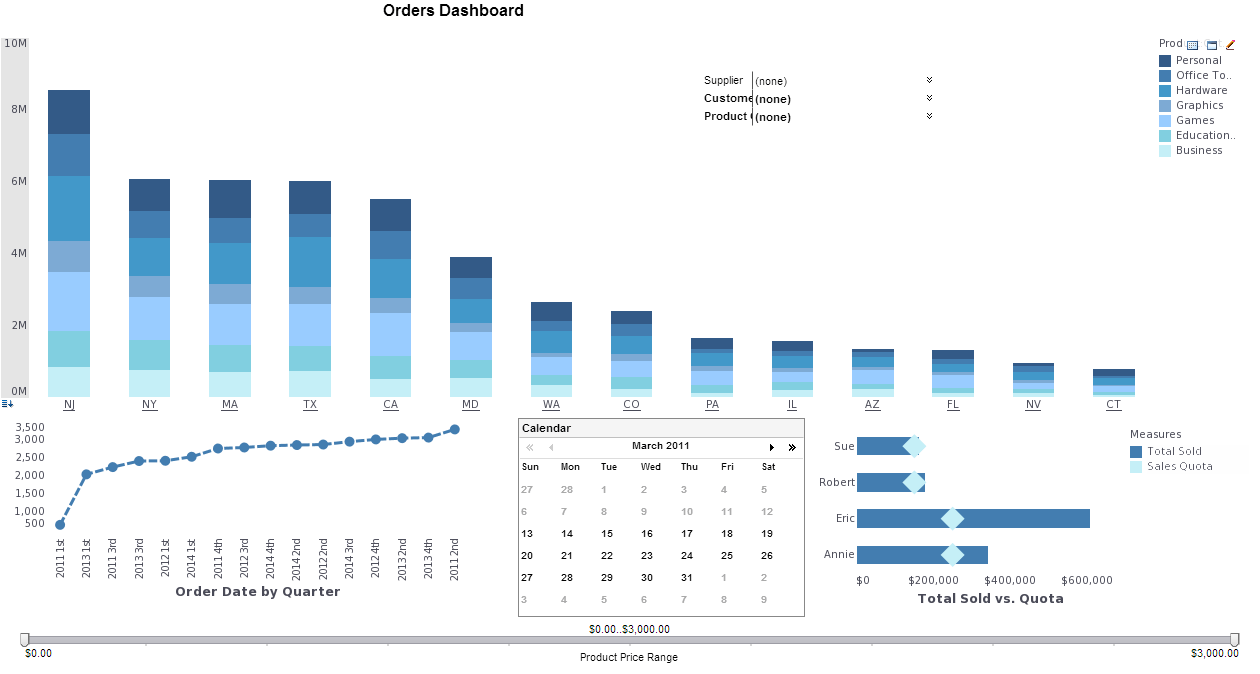Five Tips on How Analytics and Data Can Be Useful for e-Commerce Owners
In the early days of eCommerce, the first retailers had to overcome a great challenge of convincing customers to trust them. Giving out credit card numbers and personal details online was something that many didn't really trust, so Amazon and other retailers had to do a great job to get the public put their faith into this new way to pay and shop.
As customers have gotten super comfortable with shopping online, the eCommerce industry proliferated. Today, online retailers have to face yet another profound problem: the diversity of customer choice. While this may not sound like an issue at all, giving too much choice and too little assistance and guidance can:
- easily confuse customers and make them leave the site
- convince them to put off the purchase
- look for a product on a competitor's site
- visit a brick and mortar store instead.
| #1 Ranking: Read how InetSoft was rated #1 for user adoption in G2's user survey-based index | Read More |
Fortunately, eCommerce sellers can overcome this challenge by taking advantage of data analytics that predicts what a customer wishes to buy and simply the task of making a choice. For example, Amazon's product recommendation engine that studies browsing and purchase history to generate recommendations is responsible for 35 percent of the company's total sales. That's about $25 billion.
In this article, let's talk about other ways in which eCommerce sellers can use data analytics to increase sales. Let's start by discussing the problem of the diversity of customer choice in more detail.
1. Provide a Personalized Shopping Experience
It goes without saying that the eCommerce industry is booming and the choice it gives to customers is unprecedented. Nowadays, you can buy everything you need online, and there will be at least a few options to buy from. According to estimates, there are almost one million eCommerce stores in the U.S. alone, and this number triples on a global scale.
With the range of products increasing every day, too, eCommerce customer experience lacked any personal touch. For example, customers had to go through numerous product pages and highlight those they were interested in, which isn't exactly user-friendly.
On the other hand, data analytics based on the analysis of customer browsing history and purchasing history. For example, it's now possible to track products that a customer had visited, and send them personalized recommendations by email and show these products the next time they visit the website again.
And doing so is really effective, as the Amazon recommendation engine's results showed.
 |
View a 2-minute demonstration of InetSoft's easy, agile, and robust BI software. |
2. Real-Time (Dynamic) Pricing
Powerful eCommerce pricing software allows sellers to manage prices based on real-time competitor data, which can improve profitability. In fact, this Deloitte report says that effective price management in eCommerce can increase "a company's margins by 2 to 7 percent" within one year, thus producing the return on investment between 200 and 350 percent.
Simply explained, dynamic pricing occurs when an eCommerce seller changes online prices very quickly based on a range of sales factors. These include customer purchasing history, prices of competitors, and stock availability of high-demand products.
WalMart, one of the companies using real-time pricing software, is known to change its prices about 50,000 times a month, and its total sales increased by 30 percent after the introduction of the strategy.
A simple example of dynamic pricing is changing the price of a product to make it lower than competitors' so the customers know they don't need to visit more sites to make a good buy.
Read what InetSoft customers and partners have said about their selection of Style Scope for their solution for dashboard reporting. |
3. Advanced Customer Analysis
Having a good understanding of customers is essential for personalizing their experience, increasing their loyalty, and getting more purchases from them. Every eCommerce business sits on tons of customer-related data, and data analytics tools can help to finally put them to good use.
For example, this data can reveal customer preferences, demand spikes, trends, typical buying times, and other important factors. Real-time sales reports in CRM systems are great tools in this regard because they can be used to cover the whole customer journey.
If you'd like to see what a real-time sales report looks like, feel free to interact with a Live Sales Dashboard.
4. Improving Customer Service
This one is related to the previous one because customer service is a part of the holistic understanding of customers. The problem of poor customer support is well-known in eCommerce (while the exact number of losses due to poor customer service in eCommerce is extremely hard to define, there are reports suggesting losses up to $75 billion annually).
By analyzing big data, eCommerce sellers can come up with more effective customer support strategies and replace those not making the necessary effect. For example, the analysis essentially puts a seller into a customer's shoes because it provides information about their preferences, needs, and buying habits.
A lot of things can be better understood when eCommerce companies begin using customer-related data analytics. For example, by studying a customer's purchase and product return histories, one can reveal what logistics and customer service problems exist that affect the outcome of the sales.
| Next: Reducing eCommerce Fraud with Better Analytics |



